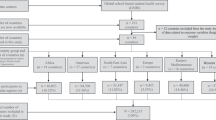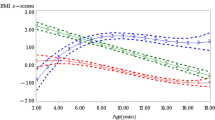Abstract
Objective:
To identify personal and environmental factors associated with adolescent overweight and obesity in Xi'an city, China.
Subjects/Methods:
A total of 1804 adolescents from 30 junior high schools in six districts in Xi'an City. Community, school, household and individual characteristics were self reported by parents, school doctors and students. Factors associated with adolescent overweight and obesity were identified using a hierarchical logistic regression.
Results:
In all adolescents, after adjustment for age and gender, factors significantly associated with overweight and obesity were: living in urban districts (odds ratio (OR): 4.0, 95% confidence interval (CI): 2.7–6.0); limited use of school sports facilities (OR: 1.7, 95% CI: 1.1–2.6); wealthy households (OR: 1.7, 95% CI: 1.1–2.6); parental restrictions on purchasing snacks (OR: 1.5, 95% CI: 1.03–2.0); having an overweight/obese parent (OR: 1.8, 95% CI: 1.3–2.5); having soft drinks more than four times per week (OR: 1.6, 95% CI: 1.02–2.5) and not fussy about foods (OR: 1.7, 95% CI: 1.2–2.2). Eating sweets was negatively associated with overweight/obesity (OR: 0.6, 95% CI: 0.4–0.9). Separate gender analyses revealed that in boys, low physical activity (OR: 2.0, 95% CI: 1.1–3.8) and higher energy intake (OR: 1.8, 95% CI: 1.1–2.9) were also associated with overweight/obesity. In girls, less school sports meetings (OR: 2.3, 95% CI: 1.3–4.0); parental decisions about eating fast foods (OR: 1.8, 95% CI: 1.1–2.9) and availability of home video games (OR: 1.7, 95% CI: 1.1–2.5) were also significant.
Conclusions:
Preventive strategies for adolescent overweight and obesity in Xi'an should address the community and school environments to reinforce behavioral change. Gender differences also need to be considered when planning interventions.
This is a preview of subscription content, access via your institution
Access options
Subscribe to this journal
Receive 12 print issues and online access
$259.00 per year
only $21.58 per issue
Buy this article
- Purchase on Springer Link
- Instant access to full article PDF
Prices may be subject to local taxes which are calculated during checkout
Similar content being viewed by others
References
Booth M, Wake M, Armstrong T, Chey T (2001). The epidemiology of overweight and obesity among Australian children and adolescents, 1995-97. Aust N Z J Public Health 25, 162–169.
Booth ML, Okely AD, Chey T, Bauman A (2002). The reliability and validity of the adolescent physical activity recall questionnaire. Med Sci Sports Exerc 34, 1986–1995.
Centres of Disease Control and Prevention. Diet Behaviour and Nutrition-DBQ. Survey Questionnaire and Exam Component 2001–2002. Atlanta: CDC, 2003.
Chao R (1994). Beyond parental control and authoritarian parenting style: understanding Chinese parenting through the culture notion of training. Child Dev 65, 1111–1119.
Chen J, Kennedy C (2004). Family functioning, parenting style, and Chinese children's weight status. J Fam Nurs 10, 262–279.
Cole T, Bellizzi M, Flegal K, Dietz W (2000). Establishing a standard definition for child overweight and obesity worldwide: international survey. BMJ 320, 1240–1243.
Davison K, Birch L (2001). Childhood overweight: a contextual model and recommendations for future research. Obes Rev 2, 159–171.
Filmer D, Pritchett L (1998a). Estimating Wealth Effects without Expenditure Data- or Tears: An Application to Educational Enrolments in States of India. World Bank Policy Research Working Paper No 1994. Washington.
Freedson P, Evenson S (1991). Familial aggregation in physical activity. Res Q Exerc Sport 62, 384–389.
Gibson E, Wardle J, Watts C (1998). Fruit and vegetable consumption, nutritional knowledge and beliefs in mothers and children. Appetite 31, 205–228.
Goetz D, Caron W (1999). A biopsychosocial model for youth obesity: consideration of ecosystemic collaboration. Int J Obes 23, S58–S64.
Hanley A, Harris S, Gittelsohn J, Wolever T, Sakasvig B, Zinman B (2000). Overweight among children and adolescents in a native Canadian community: prevalence and associated factors. Am J Clin Nutr 71, 693–700.
Hernandez B, Gortmaker S, Colditz G, Peterson K, Lairdt N, Parra-Cabrera S (1999). Association of obesity with physical activity, television programs and other forms of video viewing among children in Mexico City. Int J Obes 23, 845–854.
Hesketh T, Ding Q, Tomkins AM (2002). Disparities in economic development in Eastern China: impact on nutritional status of adolescents. Pub Health Nutr 5, 313–318.
Hill A, Franklin J (1998). Mothers, daughters, and dieting: investigating the transmission of weight control. Br J Clin Psychol 37, 3–13.
Hosmer D, Lemeshow S (1989). Model-Building Strategies and Methods for Logistic Regression. In: Hosmer D, Lemeshow S (eds.) Applied Logistic Regression. New York City: John Wiley & Sons Inc.,, 82–126.
Janssen I, Katzmarzyk P, Boyce W, Vereecken C, Mulvihill C, Roberts C et al. (2005). Comparison of overweight and obesity prevalence in school-aged youth from 34 countries and their relationships with physical activity and dietary patterns. Obes Rev 6, 123–132.
Li M, Dibley M, Sibbritt D, Yan H (2006a). An assessment of adolescent overweight and obesity in Xi'an City, China. Int J Pediatr Obes 1, 50–58.
Li M, Dibley M, Sibbritt D, Yan H (2006b). Factors associated with adolescents' physical inactivity in Xi'an City, China. Med Sci Sports Exerc 38, 2075–2085.
Lobstein T, Baur L, Uauy R (2004). Obesity in children and young people: a crisis in public health. Obes Rev 5, 4–85.
Lohman TG, Roche AF, Martorell R (1991). Anthropometric standardization reference manual. Champaign, ILL: Human Kinetics.
Ludwig D, Peterson K, Gortmaker S (2001). Relation between consumption of sugar-sweetened drinks and childhood obesity: a prospective, observational analysis. Lancet 357, 505–508.
Ma G (2002). Environmental Factors Leading to Paediatric Obesity in the Developing World. In: Chen C, Dietz W (eds.). Nestle Nutrition Workshop Series. Philadelphia, PA: Williams & Wilkins, 195–206.
Marshall S, Biddle S, Sallis J, McKenzie T, Conway T (2002). Clustering of sedentary behaviours and physical activity among youth: a cross-sectional study. Pediatr Exerc Sci 14, 401–417.
Marti A, Moreno-Aliaga M, Hebebrand J, Martinez J (2004). Genes, lifestyles and obesity. Int J Obes 28, S29–S36.
Morris N, Udry J (1980). Validation of a self-administered instrument to assess stage of adolescent development. J Youth Adolesc 9, 271–280.
Nicklas TA, Yang S, Baranowski T, Zakeri I, Berenson G (2003). Eating pattern and obesity in children: the Bogalusa heart study. Am J Pre Med 25, 9–16.
Prentice A, Jebb S (2003). Fast food, energy density and obesity: a possible mechanistic link. Obes Rev 4, 187–194.
Reilly J, Methven E, McDowell Z, Hacking B, Alexander D, Stewart L et al. (2003). Health consequences of obesity. Arch Dis Child 88, 748–752.
Resnicow K, Davis-Hearn M, Smith M, Baranowski J, Doyle C, Want D (1997). Social-cognitive predictors of fruit and vegetable intake in children. Health Psychol 16, 272–276.
Robertson S, Cullen K, Baranowski J, Baranowski T, Shaohua H, deMoor C (1999). Factors related to adiposity among children aged 3–7 yeas. J Am Diet Assoc 99, 938–943.
Rockett HRH, Breitenbach M, Frazier AL, Witschi J, Wolf A, Field A et al. (1997). Validation of a youth/adolescent food frequency questionnaire. Prev Med 26, 808–816.
Russell J, Kopec-Schrader E, Rey J, Beumont P (1992). The parental bonding instrument in adolescent patients with anorexia nervosa. Acta Psychiatr Scand 86, 236–239.
Sallis J, Patrick K (1994). Physical activity guidelines for adolescents: consensus statement. Pediatr Exerc Sci 6, 302–314.
Sallis J, McKenzie T, Alcaraz J, B K, Faucette N, Hovell M (1997). The effect of a 2-year physical education program (SPARK) on physical activity and fitness in elementary school students. Am J Pub Health 87, 1328–1334.
Summerbell C, Waters E, Edmunds L, Kelly S, Brown T, Campbell K (2005). Interventions for Preventing Obesity in Children (Review). New York City: John Wiley & Sons. Ltd.
Victora C, Huttly S, Fuchs S, Olinto M (1997). The role of conceptual frameworks in epidemiological analysis: a hierarchical approach. Int J Epidemiol 26, 224–227.
Wang L (2005). National Nutritional and Health Survey Report One-Overall Report. In: Wang L (ed.) National Nutritional and Health Survey Report Series. Beijing: People's Health Publishing House, pp 48–53.
World Health Organization (2000). Obesity: Preventing and Managing the Global Epidemic. Report of a WHO consultation. Geneva: World Health Organization. pp 58–60.
World Health Organization (1995). Physical Status: the use and interpretation of anthropometry. Report of a WHO Expert Committee. Geneva: World Health Organization. pp 276–281.
Ye J (2004). Body mass index reference norm for screening overweight and obesity in Chinese children and adolescents (in Chinese). Chin J Epidemi 25, 97–102.
Acknowledgements
This research was sponsored by a research training fellowship (066971/2/02/A) from the Health Consequences of Population Change Program of The Wellcome Trust. We thank the Municipal Education Department in Xi'an city for coordination and all the field workers for their contribution in the data collection.
Author information
Authors and Affiliations
Corresponding author
Additional information
Conflict of interest statement
None of the authors have any financial support from or relationships with organizations that might benefit from the publication of these research findings.
Rights and permissions
About this article
Cite this article
Li, M., Dibley, M., Sibbritt, D. et al. Factors associated with adolescents' overweight and obesity at community, school and household levels in Xi'an City, China: results of hierarchical analysis. Eur J Clin Nutr 62, 635–643 (2008). https://doi.org/10.1038/sj.ejcn.1602757
Received:
Revised:
Accepted:
Published:
Issue Date:
DOI: https://doi.org/10.1038/sj.ejcn.1602757
Keywords
This article is cited by
-
Sedentary behavior during leisure time, physical activity and dietary habits as risk factors of overweight among school children aged 14–15 years: case control study
BMC Research Notes (2018)
-
Etiology of Obesity Over the Life Span: Ecological and Genetic Highlights from Asian Countries
Current Obesity Reports (2014)
-
Prevalence and Factors Associated With High Body Fat in Adolescents from a Region of Brazil
Journal of Community Health (2012)
-
School environment factors were associated with BMI among adolescents in Xi'an City, China
BMC Public Health (2011)
-
The longitudinal influence of home and neighbourhood environments on children's body mass index and physical activity over 5 years: the CLAN study
International Journal of Obesity (2010)



